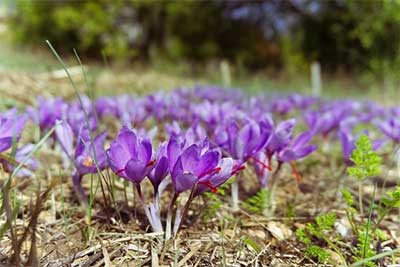Daily-current-affairs
/
09 Nov 2020
Saffron Farming in North East : Daily Current Affairs

Saffron Farming in North East
Why in NEWS ?
- The saffron bowl, which was so far confined to Kashmir, may soon expand to the North East
of India.
About
- Plants from seeds transported from Kashmir to Sikkim and acclimatized there are
now flowering in Yangyang in the Southern part of the North-East state.
- Saffron production has long been restricted to a limited geographical area in the
Union territory of Jammu & Kashmir.
- Pampore region, in India, commonly known as Saffron bowl of Kashmir, is the main
contributor to saffron production, followed by Budgam, Srinagar, and Kishtiwar
districts.
- North East Centre For Technology Application and Reach (NECTAR), an autonomous
body under the Department of Science & Technology, Government of India
supported a pilot project to explore the feasibility of growing saffron in North East
region of India, with the same quality and higher quantity.
- The Botany and Horticulture department of Sikkim Central University carried out
tests to understand the soil and actual pH conditions of Yangyang of Sikkim and
found it comparable to saffron growing places of Kashmir.
- Saffron seed/corms were purchased and air transported from Kashmir to Yangyang
site by the department.
- The saffron corms were irrigated during the month of September and October,
which ensured timely corm sprouting and good flower yields. The matching of
climatic and geographical conditions between Pampore (Kashmir) and Yangyang
(Sikkim) led to the successful sample farming of Saffron in Yangyang.
- The project also focused on post-harvest management and value addition of saffron
so that quality saffron drying and efficient post-harvest processing can improve
saffron recovery, thereby improving its production.
- Further, detailed analysis and testing of all parameters, including soil testing, quality,
quantity, and possible value addition are planned, for immediate results and
extrapolation of the project to other parts of the North East Region along with Micro
Food Enterprises
Saffron
- Saffron is a plant whose dried stigmas (thread-like parts of the flower) are used to
make saffron spice.
- Saffron has traditionally been associated with the famous Kashmiri cuisine.
- Saffron cultivation is believed to have been introduced in Kashmir by Central Asian
immigrants around the 1st Century BCE.
- Its medicinal values were considered as part of the rich cultural heritage of Kashmir.
- As saffron growing was confined to very specific areas in Kashmir, its production
remained limited.
- It is a very precious and costly product.
- It rejuvenates health and is used in cosmetics and for medicinal purposes.
- It is cultivated and harvested in the Karewa (highlands) of Jammu and Kashmir.
- Though the National Mission on Saffron focused on several measures to improve its
farming, the measures were still limited to the specified areas of Kashmir.
- The Kashmir Saffron received GI Tag in May 2020.
Season and Favourable conditions for Saffron Cultivation
- In India, saffron Corms (seeds) are cultivated during the months of June and July and
at some places in August and September.
- It starts flowering in October.
- Saffron grows well at an altitude of 2000 meters above sea level.
- It needs a sunlight of 12 hours.
- It grows in many different soil types but thrives best in calcareous (soil that
has calcium carbonate in abundance), humus-rich and well-drained soil with a pH
between 6 and 8.
- For saffron cultivation, we need an explicit climatologically summer and winter with
temperatures ranging from no more than 35 or 40 degree Celsius in summer to
about –15 or –20 degree Celsius in winter.
- It also requires adequate rainfall that is 1000-1500 mm per annum.
National Saffron Mission
- In August 2010, the Union Government has approved a plan of Rs 373 crore under
National Saffron Mission Programme (NSMP) to revive the saffron production in
Jammu and Kashmir for re-plantation of saffron corms.
- It was a four year mission that was implemented between 2010-14. Later it was
extended, as the production of saffron declined greatly in 2014.
Objectives
- To extend support for creation of irrigation facilities through tube wells and sprinkler
sets which would help in production of better crop in the area.
- Improve the overall production of saffron, enhancing its quality, enhancement of
Research and Extension capability and develop appropriate system for organised
marketing for the growers.







